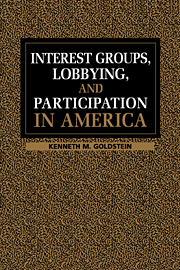Book contents
- Frontmatter
- Contents
- List of Figures and Tables
- Acknowledgments
- 1 Introduction
- 2 Patterns and Puzzles in Participation and Lobbying
- 3 The Political Logic of Political Decisions
- 4 Explaining Lobbying Decisions
- 5 Lobbying Decisions and the Health Care Reform Battle
- 6 Patterns of Recruitment and Participation in the Mass Public
- 7 Conclusion
- Appendix A Sources and Coding for Survey Data
- Appendix B Interest Group Sampling Frame
- Appendix C Chronology of Health Care Reform Legislation
- Bibliography
- Index
6 - Patterns of Recruitment and Participation in the Mass Public
Published online by Cambridge University Press: 23 September 2009
- Frontmatter
- Contents
- List of Figures and Tables
- Acknowledgments
- 1 Introduction
- 2 Patterns and Puzzles in Participation and Lobbying
- 3 The Political Logic of Political Decisions
- 4 Explaining Lobbying Decisions
- 5 Lobbying Decisions and the Health Care Reform Battle
- 6 Patterns of Recruitment and Participation in the Mass Public
- 7 Conclusion
- Appendix A Sources and Coding for Survey Data
- Appendix B Interest Group Sampling Frame
- Appendix C Chronology of Health Care Reform Legislation
- Bibliography
- Index
Summary
In the previous chapter, I used formal interviews, media accounts, and my own observations to gather information from the top down on the lobbying choices and targeting decisions of interest groups in the battle over health care reform. Consistent with theoretical expectations, the evidence revealed that the legislative targets in grass roots campaigns on health care were likely to be undecideds, key committee members, and cue givers. Greater variation existed among constituency targets – with some groups concentrating on members, employees, and stockholders, while other groups pursued more broad-based tactics. Still, the evidence indicated that lobbyists targeted more engaged and influential constituents who could be counted on to deliver the correct messages.
In this chapter, I investigate from the bottom up the impact of these decisions at the mass level. I investigate whether there is evidence among the mass public to confirm the reports of lobbyists and support my model of mobilization choices. Were citizens residing in states represented by undecideds and cue givers on key committees more likely to be contacted by interest groups? Were more educated and wealthy citizens more likely to be contacted? Were contacted citizens and those living in targeted districts and states more likely to get in touch with Congress about health care legislation or the Clinton plan?
The fundamental approach in this chapter is to add contextual information about targeted districts to individual-level survey data containing measures of participation and mobilization.
- Type
- Chapter
- Information
- Interest Groups, Lobbying, and Participation in America , pp. 106 - 124Publisher: Cambridge University PressPrint publication year: 1999



